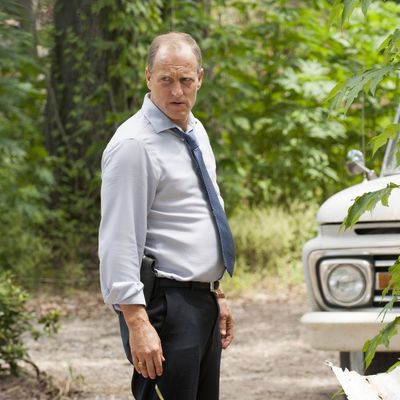
What drives a man into the heart of darkness? One can’t help but wonder as Rust forages deeper into Errol’s Carcosan shrine by Highway 27, a place moored off from Louisiana’s coastal marsh. True Detective has, at times, aspired to the philosophical and cinematographic scope of Apocalypse Now. And in “Form and Void,” Rust’s travels through vast swampland toward the Childress compound parallel Benjamin Willard’s nightmare on the Nung en route to Colonel Kurtz’s Cambodian hideout — if you allow that one man’s war-induced self-destruction is another’s trauma brought on by personal loss.
It’s hard to say what closure Captain Willard anticipated on the other side of horror. But it turns out Rust — to no one’s greater surprise and mixed emotion than his own upon waking from a coma — was merely looking for some light (specifically one that shines upon a reunion with his daughter). In a just world, that’s where all trails and evidence eventually lead, and it’s what true detectives are after. It’s also why, as Marty puts it during he and Rust’s Lethal Weapon bonding sesh, guys like Rust are so “un-killable,” or at least less flappable than, say, preacher Joel Theriot, who folded his revival tent right quick after witnessing what the Tuttles were capable of.
In fairness, most of us would do the same in Joel’s holy loafers. Likewise, we’d probably fumble, sweat, and wince our way through Errol’s ghoulish haunted house along with Marty, whose instincts have always been stronger than his stomach. And the scene at Childress manor is grisly. Father Billy is dead and strapped down flat on his back, mouth sewn shut and kept separate from the main house in conditions that would make Mrs. Bates’s corpse thank Norman for his consideration. Within Errol and his half-sister lover’s primary residence, there’s all the troubling keepsakes of unleashed psychosis: baby dolls, empty hangers for tiny dresses, piles of newspapers and other refuse, dried blood, and pine-tree air fresheners dangling à la devil’s nests that hang like someone’s idea of a sick joke. It’s all Marty can do not to lose his shit until he gets what he came for inside this future demolition site: a phone, offscreen, to call in the cavalry (Papania and Gilbough). And then it’s time to hail the Yellow King.
Marty knows he’s no hero. He doesn’t need anyone to tell him that, including Rust, who needles him still about a history of cowardice, lies, and erratic values. After all they’ve been through, here they are again, driving to investigate a crime (or now a series of crimes), failing terribly at small talk, smelling aluminum and ash (or at least Rust is). That’s the moment where True Detective truly came full circle. Its final half hour was, for Rust and Marty, what fate deferred for nearly two decades, and for us viewers, what two months of mystery had amounted to.
And far as answers, to once again parrot Marty — who even Rust begins to acknowledge knows a hell of a lot —“We ain’t gonna get ’em all. That ain’t what kinda world it is.” We won’t know if Senator Tuttle carries on the Carcosan way; whether brow-furrowing CID Commander Speece was complicit; if Audrey was in any way solicited by Errol or simply privy to rumors of what happened to missing children (or is just in the pantheon of troubled TV kids); or when and if Sheriff Geraci (he’s a sheriff, goddamnit!), whose gutlessness underscores Marty’s conviction in comparison, gets his revenge on those meddling private dicks.
Sometimes you work with what’s certain. For Marty and Rust, that meant puzzling out Errol’s guilt (and, for that matter, existence), ending a terrible chapter in dozens of families’ lives and making sure Errol can’t use Louisiana’s next natural disaster as a means to go off-grid and dispatch a network of desperate, depraved acolytes to carry out unspeakable deeds. For those watching at home, it provided an anxious and imaginative conclusion, one that stirred up ghosts of familiar tragedies as a backdrop to masterfully crafted suspense and surreal violence.
There was, as has been the case throughout, more than a little humor and cliché in “Form and Void,” from Rust and Marty’s dueling middle fingers to Errol and Mrs. Errol’s overall bayou-bogey-folk eccentricity (when was the last time your partner made flowers on you?). Odds are those playful details will pop on second viewings, despite the show’s prevailing seriousness. Even Rust looks skyward and reminds himself and Marty that, “Once there was always dark. If you ask me, the light’s winning.” And True Detective, in turn, illuminated a black-and-white crime-and-coppers story with winning oddness to its end.
Apart from all that:
Who could say no to Mrs. Errol’s frowny-face? Not Errol.
Errol just couldn’t resist erecting Dora’s carcass as a tableau of however Grandpa violated Mrs. Errol in those cane fields.
“Fuck you, man” is the closest Rust gets to a professional compliment.
Now that was an awkward conversation about Maggie between Rust and Marty.
Again, watching them track down the Childresses through genuine detective work was invigorating. (And how perfect that the “tax man” got to Errol through IRS records.)
Great moment when Papania loses his cool and patience with what he receives as Marty and Rust’s “white man” manipulation.
Errol’s far-off dialogue in Carcosa is just waiting to be sampled.
Marty’s epic gut.
Thanks for making this so communal each week, everyone. And happy Carcosa to you!




